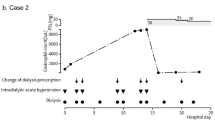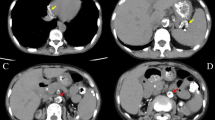Abstract
Icodextrin is a starch-derived glucose polymer used in peritoneal dialysis dialysate to treat volume overload by increasing ultrafiltration in patients with end-stage renal disease. Reported adverse reactions to icodextrin are mild and rare and mainly consist of skin rash that resolves spontaneously after discontinuation of treatment. We describe a young patient with extreme eosinophilia that appeared with the use of icodextrin, disappeared after its discontinuation, and reappeared after a rechallenge with the drug. The eosinophilia was not associated with peritonitis, was asymptomatic, and fully resolved after discontinuation of the drug. Severe eosinophilia can potentially cause tissue damage in several organs, which would indicate that blood eosinophil count is recommended in routine complete blood counts while icodextrin peritoneal dialysis is being administered.
Similar content being viewed by others
References
Chandran PK, Humayun HM, Daugirdas JT, Nawab ZM, Gandhi VC, Ing TS (1985) Blood eosinophilia in patients undergoing maintenance peritoneal dialysis. Arch Intern Med 145:114–116
Patel UO, Fox SR, Moy JN, Korbet SM (2011) Pruritic rash and eosinophilia in a patient receiving peritoneal dialysis. Semin Dial 24:338–340
Davies SJ, Woodrow G, Donovan K, Plum J, Williams P, Johansson AC, Bosselmann HP, Heimbürger O, Simonsen O, Davenport A, Tranaeus A, Divino Filho JC (2003) Icodextrin improves the fluid status of peritoneal dialysis patients: results of a double-blind randomized controlled trial. J Am Soc Nephrol 14:2338–2344
Canepa A, Verrina E, Perfumo F (2008) Use of new peritoneal dialysis solutions in children. Kidney Int Suppl :S137-144
MacGinley R, Cooney K, Alexander G, Cohen S, Goldsmith DJ (2002) Relapsing culture negative peritonitis in peritoneal dialysis patients exposed to icodextrin solution. Am J Kidney Dis 40:1030–1035
Martis L, Patel M, Giertych J, Mongoven J, Taminne M, Perrier MA, Mendoza O, Goud N, Costigan A, Denjoy N, Verger C, Owen WF Jr (2005) Aseptic peritonitis due to peptidoglycan contamination of pharmacopeia standard dialysis solution. Lancet 365:588–594
Chan MK, Chow L, Lam SS, Jones B (1988) Peritoneal eosinophilia in patients on continuous ambulatory peritoneal dialysis: a prospective study. Am J Kidney Dis 11:180–183
Roufosse F, Weller PF (2010) Practical approach to patient with hypereosinophilia. J Allergy Clin Immunol 126:39–44
Author information
Authors and Affiliations
Corresponding author
Ethics declarations
Conflict of interest
The authors declare that they have no conflict of interest.
Additional information
This refers to the article that can be found at https://doi.org/10.1007/s00467-017-3845-7.
Rights and permissions
About this article
Cite this article
Tzvi-Behr, S., Frishberg, Y., Ben-Shalom, E. et al. Eosinophilia in a peritoneal dialysis patient: Answers. Pediatr Nephrol 33, 1507–1508 (2018). https://doi.org/10.1007/s00467-017-3847-5
Received:
Revised:
Accepted:
Published:
Issue Date:
DOI: https://doi.org/10.1007/s00467-017-3847-5




